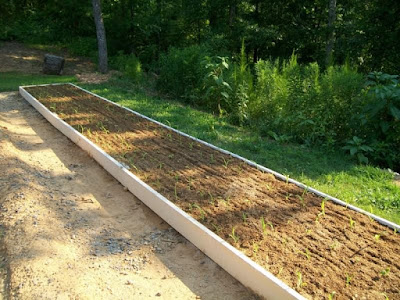Tuesday, June 27, 2017
Friday, April 14, 2017
Weed 'Early and Often"
 |
Vegetables are better for you if they have been grown without pesticides. One good way to keep the bugs off our plants is to have clean, weed-free aisles, and garden boxes. |
 |
The secret to weeding is to pull them up when they are tiny. This keeps the bugs much further from our plants and makes the garden look well kept. |
 |
A two-way hoe also makes weeding easy. It just rakes across the soil and catches the weeds by their roots. I've only seen this at Ace hardware in Cullman (in the Piggy Wiggy) but the hoe can be order at Growfood.com. This organization donated one to Hulaco. |
 |
| When crabgrass is about the size of a quarter is the best time to pull it up. |
 |
Crabgrass makes a star shape and is still easy to pull up at this stage. |
 |
If crabgrass gets big, it may take a shovel to get it out. The motto for weeding is "Early and Often". You can tell it's a weed if it's not growing in a straight line near the water pipes in the garden. Weeding the garden is easy if it's done just a few minutes each week. I hope you have great success with your garden. To get more inspiration check out the Mittleider Garden group on Facebook or click here to go back. |
How to shop for plants and seeds
Once you have your plants and seeds, it's time to plant the garden or click here to return!
Wednesday, March 22, 2017
Choose a Sunny Location
 |
| Because plants use energy from the sun to make fruit choose a garden spot that gets sun all day or at least 6 hours. 8 hours is even better. |
TIP: On a sunny day, use your phone and make a short video of your yard every hour or two. Note the time the sunlight first shines on potential garden spots and when it moves away from the area. By the end of the day, you'll have found your perfect spot. Vegetables need six full hours of sun but it can be collective, morning and afternoon sun. Remember to account for nearby trees that will continue to grow and encroach on your garden light.
 |
| Our sunny spot was on the other side of the yard. This spot drained well with no standing water. The ground wasn't level but we were able to move dirt around and level the area. |
 |
| ...and it was near a water source. |
 |
| This is another idea for leveling a sunny spot is this garden by Steve and Beth Morril. |
 |
| The best garden spot may not be in the backyard like the grass by this sunny wall. |
When you've found your garden spot, then it's time to choose a garden style or here to return.
Tuesday, March 21, 2017
Decide on a garden style
 |
| You could make a container garden. Wicker is ideal because it drains well. |
 |
| In ground with a T-frame. Notice how he cleared the whole area then pulled from the sides to pile up this ridges. T-frames are good for pole beans, tomatoes, and cucumbers. |
 |
Well almost everything, the okra by the fence on the far right didn't grow as fast as the beans, oops.
|
 |
| This is a double box without a T-frame. He has five rows of corn growing in this box. |
 |
| This is Jim and Araksya Kennard's home. This garden box has tomatoes, cucumbers and honey dew melon hanging. He used a double T-Frame that is 6' wide at the top. Jim is the one that brought Mittleider Gardening to Alabama. These T-frames were donated and relocated to a girl's camp. Click here to see pictures of the project. |
 |
| Another option for a garden box is to not use purchased wood. Teresa and Cris Partain's garden box is made from tree trunks. They planted in leaf mulch and sand. |
 |
| They even used logs for the wood at the top. |
 |
| Small melons, pole beans, tomatoes, peas, and cucumbers work best on T-Frames. |
If you've found a good spot for your garden and have decided what type you want -- then it's time to start digging or click here to return!
Monday, March 20, 2017
Constructing Your Garden
This can be done with a shovel or a tiller.
With a tiller, till down only about 2 inches. then with a metal rake, rake the grass and weeds away. Then till again about 8-10 inches to have dirt to shape the beds.
 |
| Can you see how he used a rake to pull dirt from the isle? |
I'm sure at this point you would love a video. This is a video of Jim Kennard demonstrating how to make a garden in the ground. This is a handout that shows the layout of the garden beds.





























